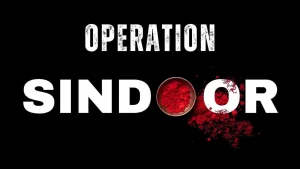High Alert at India-Pakistan Border
Tensions between India and Pakistan surged dramatically on May 8, 2025. A significant military confrontation occurred near the India-Pakistan border, with a Pakistani jet shot down by Indian forces near Pathankot. This marked a sharp escalation in the ongoing conflict that has gripped both nations for weeks. The jet, allegedly attempting a strike on Indian military positions, was intercepted by India’s air defence systems. This encounter is part of a broader military engagement following recent cross-border attacks and counter-offensives.

Also Read : Pakistan Imposes Nationwide Emergency Lockdown Amid Escalating Conflict with India
Pakistan’s Coordinated Missile and Drone Attack
According to defence sources, Pakistan launched a series of missile and drone strikes across Indian territories on Thursday. At least eight missiles targeted key Indian military installations in Jammu and Pathankot, including the strategic Jammu Airport at Satwari. Drones were used for both reconnaissance and potential strike missions. The attack was launched around dusk, catching local civilians by surprise.
Pakistani drones flew deep into Indian airspace, prompting sirens in multiple cities. Defence analysts believe this attack was a direct response to India’s recent airstrikes under Operation Sindoor.
India’s Swift and Decisive Response
Indian air defence teams immediately activated a multilayered defence strategy. The S-400 missile defence system, imported from Russia, played a crucial role in neutralizing the aerial threats. Alongside it, India deployed surface-to-air missiles and an advanced anti-drone system that tracked and destroyed several UAVs.
The Pakistani jet shot down by Indian forces near Pathankot was part of a larger squadron entering Indian airspace. Indian radars detected the intrusion in real time. The pilot was warned but continued the mission. The intruding aircraft was swiftly targeted and brought down before reaching its intended target.
Military sources confirmed that no Indian assets were damaged in the engagement. It was one of the most successful interceptions by Indian forces in recent years.
Intelligence Behind the Interception
The successful targeting of the Pakistani aircraft and missiles relied heavily on real-time satellite intelligence and multi-node surveillance. Indian defence intelligence had picked up signs of Pakistani movement earlier that day. Their missile platforms were seen becoming active across border districts in Punjab and Pakistan-occupied Kashmir (PoK).
India deployed its Integrated Air Command and Control System (IACCS) to monitor the airspace around-the-clock. As a result, both the Pakistani jet shot down by Indian forces near Pathankot and accompanying drones were countered swiftly and with precision.
Civilian Life Disrupted by Border Escalation
The conflict has deeply affected civilian populations in border states like Jammu and Kashmir, Punjab, and Rajasthan. Following the attack, Jammu city experienced a blackout triggered by emergency safety protocols. Residents reported hearing two loud explosions which were later confirmed as the destruction of enemy drones.
In Rajasthan, especially in the Jaisalmer sector, blackouts were imposed to reduce visibility for incoming drones and aircraft. Panic spread among residents as local authorities enforced curfews and advised people to remain indoors. Emergency shelters and bunkers were activated in several villages.

Operation Sindoor: India’s Counter-Offensive
The missile and drone attacks came a day after India launched Operation Sindoor—a counter-terror operation targeting camps in Pakistan and PoK. Indian missiles destroyed nine terror hubs, including a radar station in Lahore, which reportedly coordinated the drone strike that followed.
The Ministry of Defence (MoD) confirmed that India had used precision-guided munitions and high-altitude drones for the operation. These pre-emptive strikes were launched after credible intelligence suggested imminent terror activity in Indian cities.
The Pakistani jet shot down by Indian forces near Pathankot was reportedly attempting retaliation for these strikes. The MoD stated India will continue to respond “firmly and proportionately” to any military provocations from across the border.
Diplomatic Standoff and Global Reactions
As military tensions climb, diplomatic communications between the two nations have deteriorated. India holds Pakistan accountable for cross-border terrorism and aggression. Meanwhile, Pakistan accuses India of violating its airspace and targeting non-military sites.
Foreign Secretary Vikram Misri addressed the media, declaring that de-escalation lies solely in Pakistan’s hands. He insisted that India only responded to “unprovoked aggression stemming from the Pahalgam massacre.”
Global powers like the United States, China, and Russia have expressed deep concern. Washington has offered to mediate while urging restraint from both sides. Saudi Arabia and Iran are reportedly working behind the scenes to broker a ceasefire. However, India maintains that it will not negotiate under the threat of violence.
Strategic Importance of Pathankot Sector
The Pathankot sector, where the jet was downed, holds high military value. It houses an airbase, several army units, and command installations. Any breach in this area would severely compromise India’s northern military operations.
Pathankot has previously been targeted, most notably in the 2016 terror attack, which resulted in significant casualties. The recurrence of activity in this region indicates that Pakistan views it as a prime target. This makes the successful interception of the Pakistani jet shot down by Indian forces near Pathankot even more crucial from a strategic standpoint.


What Happens Next? A Fragile Path Forward
With tensions at a boiling point, further escalation could spiral into a broader military conflict. Both sides are now on high alert, with additional troop deployments reported near the Line of Control (LoC) and International Border (IB).
While backchannel diplomacy is ongoing, no ceasefire agreement has been reached yet. India’s leadership has emphasized a zero-tolerance policy towards infiltration and aggression. Meanwhile, Pakistan’s military continues to test Indian defences.
The future remains uncertain. However, India has made it clear that its national security cannot be compromised. Any further aggression will face an immediate and forceful response.
Border Clashes Reach Dangerous New Heights
The confirmed Pakistani jet shot down by Indian forces near Pathankot underscores a dangerous new phase in India-Pakistan relations. With advanced military hardware, intelligence-driven responses, and diplomatic isolation of Pakistan, India has demonstrated both strength and resolve.
As global leaders call for peace, the two nations stand at a precipice. A misstep from either side could lead to severe consequences. For now, the world watches closely as India stands guard—defending its borders and its people.

